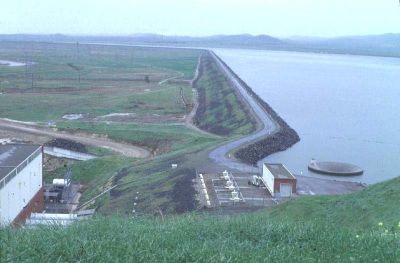First Filling and Monitoring

|
| Earth embankment dam. |
The initial filling of a reservoir is the first test that the dam will perform the function for which it was designed. A carefully managed first filling is crucial to the future success of a dam. According to a study completed by the Bureau of Reclamation on internal erosion failure modes, “approximately two-thirds of all failures and one-half of all dam incidents occur on first filling or in the first 5 years of reservoir operation.”[1]
"An initial reservoir filling and surveillance plan should be prepared by the design staff. Initial filling should be well documented, including a record of reservoir elevations and controlled water releases during the filling. The record should include complete written justification and design approval of any deviations from the planned filling. The surveillance record should include all information obtained from inspection of the dam, appurtenant structures, abutments, and reservoir rim during the initial filling."[2]
"If an embankment dam were to fail under conditions that could be appropriately defined by a limit-equilibrium analysis, it would do so at one of three critical periods... during construction... first filling... [and] achievement of maximum pore pressure under a full reservoir."[3]
"The second critical period is the first filling of the reservoir. If the dam survives the initial filling and if there is no blowup at the toe, the dam can be considered safe (in effect proof-tested) against failure by piping due to heave... Under many circumstances, including the presence of relatively thin cores or ample well-drained downstream shells, pore-pressure maxima follow so rapidly after the first filling that the survival of the first filling can be considered to be a demonstration of the ultimate safety of the dam under full-reservoir conditions. However, if the impervious section of the dam is thick and impermeable enough to create a time lag between the rise of the reservoir and the rise of piezometric levels in the core or supporting downstream zones, pore-pressure equilibrium may not occur for several years after the reservoir is first filled and the critical period may be delayed."[3]
"The factor of safety of a dam that survives its first filling and the associated increases in pore pressure will increase with time, unless this factor of safety is so close to unity that cyclic loading produced by fluctuations in the level of the pool causes strain softening and a critical loss of strength."[3]
"Requirements for initial filling should be available and should be agreed upon. During this time extra precautions and procedures for operation should be established because unpredictable situations may occur. During the first filling the facility should be attended continuously."[4]
Examples
![]() Learn more about the need to plan and monitor the first filling of a reservoir (DamFailures.org)
Learn more about the need to plan and monitor the first filling of a reservoir (DamFailures.org)
![]() Learn more about the failure of the Teton Dam in 1976 during its first filling (DamFailure.org)
Learn more about the failure of the Teton Dam in 1976 during its first filling (DamFailure.org)
Best Practices Resources
![]() Design Standards No. 13: Embankment Dams (Ch. 2: Embankment Design), USBR, 2012
Design Standards No. 13: Embankment Dams (Ch. 2: Embankment Design), USBR, 2012
![]() Design Standards No. 13: Embankment Dams (Ch. 4: Static Stability Analysis), USBR, 2011
Design Standards No. 13: Embankment Dams (Ch. 4: Static Stability Analysis), USBR, 2011
![]() Federal Guidelines for Dam Safety (FEMA P-93), FEMA, 2004
Federal Guidelines for Dam Safety (FEMA P-93), FEMA, 2004
![]() Slope Stability (EM 1110-2-1902), USACE, 2003
Slope Stability (EM 1110-2-1902), USACE, 2003
![]() Design of Small Dams, USBR, 1987
Design of Small Dams, USBR, 1987
Trainings
![]() On-Demand Webinar: Introduction to Embankment Dams
On-Demand Webinar: Introduction to Embankment Dams
![]() On-Demand Webinar: Why Embankments Crack and How to Fix Them
On-Demand Webinar: Why Embankments Crack and How to Fix Them
![]() On-Demand Webinar: Cracking and Hydraulic Fracturing in Embankment Dams and Levees
On-Demand Webinar: Cracking and Hydraulic Fracturing in Embankment Dams and Levees
![]() On-Demand Webinar: Internal Drainage Systems for Embankment Dams
On-Demand Webinar: Internal Drainage Systems for Embankment Dams
![]() On-Demand Webinar: Teton Dam – The Failure That Changed an Industry
On-Demand Webinar: Teton Dam – The Failure That Changed an Industry
![]() On-Demand Webinar: Strength Selection for Static Slope Stability Analysis
On-Demand Webinar: Strength Selection for Static Slope Stability Analysis
Citations:
- ↑ Internal Erosion Risks. Best Practices in Dam and Levee Safety Risk Analysis Presentation Series, USBR, 2012
- ↑ Federal Guidelines for Dam Safety (FEMA P-93), FEMA, 2004
- ↑ 3.0 3.1 3.2 Design Standards No. 13: Embankment Dams (Ch. 4: Static Stability Analysis), USBR, 2011
- ↑ Design of Small Dams, USBR, 1987
Revision ID: 6713
Revision Date: 03/17/2023
